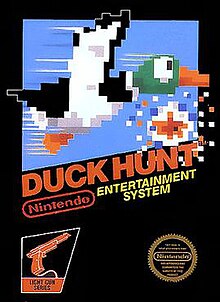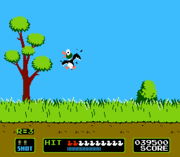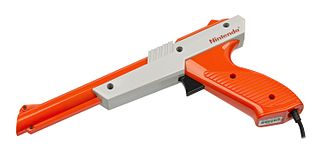
A light gun is a pointing device for computers and a control device for arcade and video games, typically shaped to resemble a pistol.
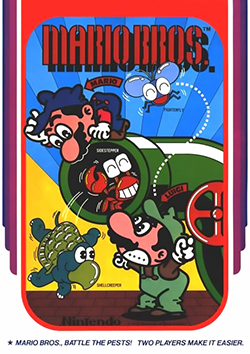
Mario Bros. is a platform game developed and published by Nintendo as an arcade video game in 1983. It was designed by Shigeru Miyamoto and Gunpei Yokoi, Nintendo's chief engineer. Italian twin brother plumbers Mario and Luigi exterminate creatures, like turtles (Koopas) and crabs emerging from the sewers by knocking them upside-down and kicking them away. The Famicom/Nintendo Entertainment System version is the first game produced by Intelligent Systems. It is part of the Mario franchise, but originally began as a spin-off from the Donkey Kong series.

A game controller, gaming controller, or simply controller, is an input device or input/output device used with video games or entertainment systems to provide input to a video game. Input devices that have been classified as game controllers include keyboards, mice, gamepads, and joysticks, as well as special purpose devices, such as steering wheels for driving games and light guns for shooting games. Controllers designs have evolved to include directional pads, multiple buttons, analog sticks, joysticks, motion detection, touch screens and a plethora of other features.

Gunpei Yokoi, sometimes transliterated as Gumpei Yokoi, was a Japanese toy maker and video game designer. As a long-time Nintendo employee, he was best known as creator of the Game & Watch handheld system, inventor of the cross-shaped Control Pad, the original designer of the Game Boy, and producer of a few long-running and critically acclaimed video game franchises such as Metroid and Kid Icarus.

The NES Zapper, also known as the Video Shooting Series light gun in Japan, is an electronic light gun accessory for the Nintendo Entertainment System (NES) and the Japanese Famicom. It was released in Japan for the Famicom on February 18, 1984, and launched alongside the NES in North America in October 1985.

R.O.B. is a toy robot accessory for the Nintendo Entertainment System (NES). It was launched in July 1985 as the Family Computer Robot in Japan, and October 1985 as R.O.B. in North America. Its short lifespan yielded only two games in the Robot Series: Gyromite and Stack-Up.

Balloon Fight is an action video game developed by Nintendo and HAL Laboratory and published by Nintendo. The original arcade version was released for the Nintendo VS. System internationally as Vs. Balloon Fight, while its Nintendo Entertainment System counterpart was released in Japan in 1985 and internationally in 1986.

Excitebike is a motocross racing video game developed and published by Nintendo. In Japan, it was released for the Famicom in 1984 and then ported to arcades as VS. Excitebike for the Nintendo VS. System later that year. In North America, it was initially released for arcades in 1985 and then as a launch game for the Nintendo Entertainment System later that year, becoming one of the best-selling games on the console. It is the first game in the Excite series.

Masayuki Uemura was a Japanese engineer, video game producer, and professor. He was known for his work as an employee of Nintendo from 1971 to 2004, most notably for serving as a key factor in the development of the Nintendo Entertainment System.

The Nintendo VS. System is an arcade system that was developed and produced by Nintendo. It is based on most of the same hardware as the Family Computer (Famicom), later released as the Nintendo Entertainment System (NES). As Nintendo was planning to release the NES in North America, they were aware of the video game crash of 1983 and its effects on the home console market. However by March 1984 the arcade industry recovered enough for a plan to introduce NES titles there, with the VS. System later being a presentation to players who did not yet own the console. It became the first version of the Famicom hardware to debut in North America.

Hogan's Alley is a light gun shooter video game developed and published by Nintendo. It was released for the Family Computer in 1984 and then the arcade Nintendo VS. System and Nintendo Entertainment System in 1985. It was one of the first hit video games to use a light gun as an input device, along with Nintendo's Duck Hunt (1984). The game presents players with "cardboard cut-outs" of gangsters and innocent civilians. The player must shoot the gangs and spare the innocent people. It was a major arcade hit in the United States and Europe.

Wild Gunman is a light gun shooter game developed and published by Nintendo. Originally created as an electro-mechanical arcade game in 1974 by Gunpei Yokoi, it was adapted to a video game format for the Famicom console in 1984. It was released in 1985 as a launch game for the Nintendo Entertainment System (NES) with the Zapper light gun.

The history of the Nintendo Entertainment System (NES) spans the 1982 development of the Family Computer, to the 1985 launch of the NES, to Nintendo's rise to global dominance based upon this platform throughout the late 1980s. The Family Computer or Famicom was developed in 1982 and launched in 1983 in Japan. Following the North American video game crash of 1983, the Famicom was adapted into the NES which was launched in North America in 1985. Transitioning the company from its arcade game history into this combined global 8-bit home video game console platform, the Famicom and NES continued to aggressively compete with next-generation 16-bit consoles, including the Sega Genesis. The platform was succeeded by the Super Famicom in 1990 and the Super Nintendo Entertainment System in 1991, but its support and production continued until 1995. Interest in the NES has been renewed by collectors and emulators, including Nintendo's own Virtual Console platform.

The history of Nintendo is from 1889 to the present, starting as a playing-card company to eventually becoming a multinational video game conglomerate. It has always remained headquartered in Kyoto, Japan.

The Mysterious Murasame Castle is an action-adventure video game developed by Nintendo and Human Entertainment and published by Nintendo for the Family Computer Disk System. It was released exclusively in Japan on April 14, 1986. The game was one of the early games released for the system, and the second original game after The Legend of Zelda. The game was released outside Japan for the first time on the Nintendo 3DS Virtual Console in Europe and Australia in May 2014 and in North America in August. It was added to the Nintendo Switch Online service on October 31, 2023.
Light-gun shooter, also called light-gun game or simply gun game, is a shooter video game genre in which the primary design element is to simulate a shooting gallery by having the player aiming and discharging a gun-shaped controller at a screen. Light-gun shooters revolve around the protagonist shooting virtual targets, either antagonists or inanimate objects, and generally feature action or horror themes and some may employ a humorous, parodic treatment of these conventions. These games typically feature "on-rails" movement, which gives the player control only over aiming; the protagonist's other movements are determined by the game. Games featuring this device are sometimes termed "rail shooters", though this term is also applied to games of other genres in which "on-rails" movement is a feature. Some, particularly later, games give the player greater control over movement and in still others the protagonist does not move at all. On home computer conversions of light-gun shooters, mouse has been often an optional or non-optional replacement for a light gun.

The Nintendo Entertainment System (NES) is an 8-bit home video game console produced by Nintendo. It was first released in Japan on 15 July 1983 as the Family Computer (Famicom). It was then released in American test markets on 18 October 1985 as the redesigned NES, and fully launched in the United States the following year. The NES was distributed in Europe, Australia, and parts of Asia throughout the 1980s under various names. As a third generation console, it primarily competed with Sega's Master System and the Atari 2600.

Super Contra, known as Super Contra: The Alien Strikes Back in Japan, is a run and gun video game by Konami, originally released as a coin-operated arcade video game in January 1988. It is the sequel to the original Contra and part of the Contra series. The game stars Bill Rizer and Lance Bean as they are sent to thwart another alien invasion from the vicious Red Falcon.
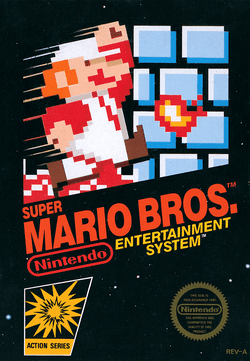
Super Mario Bros. is a platform game developed and published in 1985 by Nintendo for the Famicom in Japan and for the Nintendo Entertainment System (NES) in North America. It is the successor to the 1983 arcade game Mario Bros. and the first game in the Super Mario series. Following a US test market release for the NES, it was converted to international arcades on the Nintendo VS. System in early 1986. The NES version received a wide release in North America that year and in PAL regions in 1987.
